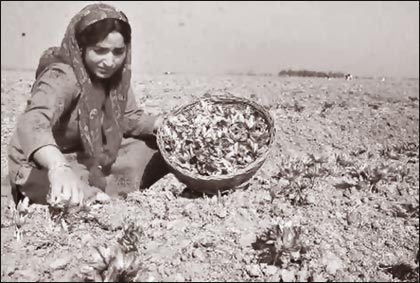Saffron flower cultivation
In Kashmir valley:
Upali Rupasinghe
Saffron is not just an another type of flower with a different smell.
It is a flower with a value similar to gold or platinum. It is also a
tiny flower surrounded with legends and with medicinal richness. Believe
it or not, Saffron is the most expensive flower in the world.
Saffron is an important part of the Kashmir’s economy and the
culture. It brings millions of rupees annually from foreign countries as
well as from other parts of India to the farmers in Kashmir.
|

Saffron is a wonderful plant with a fascinating fragrance,
pleasant flavour. Courtesy: Google |
In Kashmir, Brahmins and Buddhists have surrounded this flower with
legends.
Buddhists legends record that Kashmir was formerly a vast lake,
inhabited by a fierce dragon. In accordance with a prophesy of the
Buddha, the beast was tamed and the waters were drained by a monk called
Arahat Madhyandina, who settled in the new land and planned towns and
villages. He advised the people to take to the cultivation of Saffron,
growing on the Gonghanadana mountain.
The monk led the men of the township to the mountain. But the
guardians of the saffron bulbs, the dragons, challenged the trespassers
before they heard the Buddha’s prophesy and were pacified.
Later they promised “For as long as the doctrine of the Buddha
endures you will be allowed to use the produce of these mountains.”
The Brahminical legend has it that Takshaka Naga, the serpent king
who was once suffering from sore eyes went in disguise to Waghbhatta, a
physician from Padampura, present Pampur for treatment. The physician,
unable to relieve the Naga of his trouble, asked him to reveal his
identity. When this was done the physician at once comprehended the
reasons for the serpent’s problem that previous ointments were being
neutralised by the poisonous fumes breathed out by the Naga.
The physician therefore, first applied medicine and then covered the
snake’s eyes with a bandage. Takhsaka was restored to health and in
gratitude he gifted a Saffron bulb to the physician. The cultivation of
Saffron thus started in the Kashmir Valley.
It has variously been used throughout the civilized world, as an
important ingredient in Hindu rites and rituals and as an additive in
food preparations.
The Kashmiri sprinkle it on pillau, sweetmeats and yoghurt. Besides,
they use it in some meat dishes and tea. Saffron is usually soaked in
lemon juice, but a stronger aroma is obtained by putting it in fairly
hot water. It is also utilized to flavour and colour food, confectionary
and medicines.
In the Indian system of medicine, it been used from early times as a
sedative, as well as in fevers and melancholia.
According to a research article published in Swagat, Saffron is grown
as a pure crop. Its cultivation, however, is an arduous and expensive
task. Requiring a cool and sunny climate, it flourishes best up to an
altitude of 2,140 metres. During the pre-flowering period, 100-150
millimetres of rainfall is essential for its speedy growth. It needs an
acidic soil.
The preparation of land starts in March/April. Fields are ploughed
four times to a depth of 30 centimetres. Another ploughing is done in
May. The fields are divided into small beds of over one square metre -
in a chessboard pattern. Each one rises a little higher than the other,
or has a gentle incline. Each bed has a little trench - essential for
the drainage of excess rainwater.
Saffron is a perennial, low growing herb, very tender and tiny, about
six centimetres high. Its sharp, needle-like leaves which are about ten
centimetres long appear after the flowers. The long, tubed, funnel
shaped flower, about four centimetres long springs directly from the
soil. The flower comprises six petals and as many stamens.
Saffron’s chief pigment is its yellowish glycocide, crotin and
pierocrocin. The latter is the bitter part of the pigment.
Picking flowers is a hard and backbreaking job. The farmer has to go
to the field in the early hours of the morning and bend low to pick the
flowers by hand. Flowers wilt within hours of coming into full bloom.
The beauty and grandeur of the sea of Saffron blooms unfold during
full moon nights. As the moon rises higher and higher in the sky, and
the air is suffused with an over-powering fragrance. Pampur damsels come
out of their little hamlets to dance.
For generations, Kashmiris are proud of their own flower, Saffron,
the red gold. |



